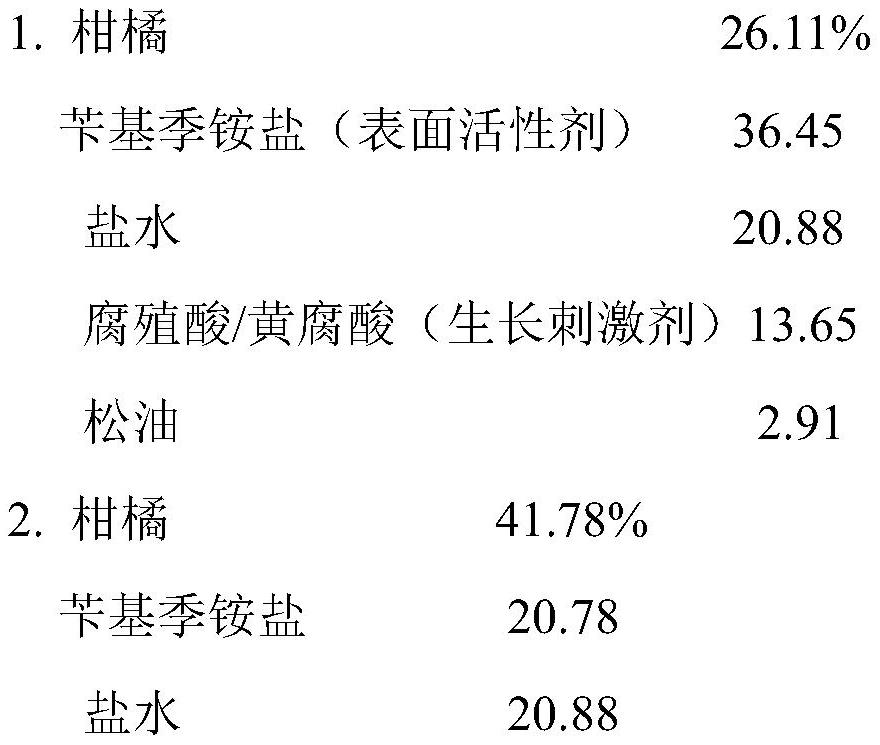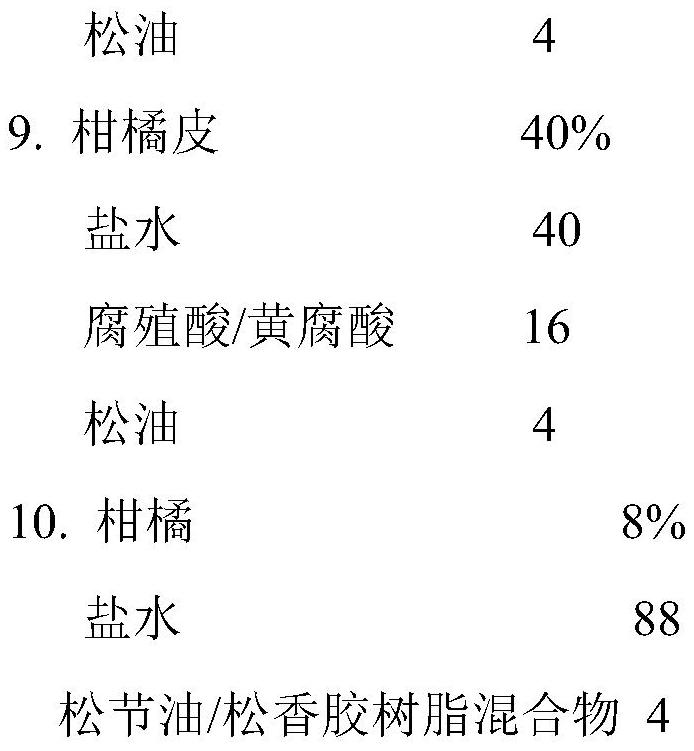Method of treating citrus greening
A citrus oil, disease technology, applied in the fields of botanical equipment and methods, animal husbandry, biocides, etc., can solve problems such as not seeing any positive results
- Summary
- Abstract
- Description
- Claims
- Application Information
AI Technical Summary
Problems solved by technology
Method used
Image
Examples
Embodiment 1
[0119] Florida Hamlin Orchard Field Trial
[0120] June 27, 2017
[0121] Place
[0122] Umatilla, FL
[0123] Crop Varieties
[0124] Hamlin Orange Tree (8'-10' tall)
[0125] Planted on January 1, 2005
[0126] time limit
[0127] The fruit was harvested on November 14, 2017
[0128] Field trials began on June 27, 2017 at Hamlin Orchards in Umatilla, Florida. Fifteen randomly selected trees were selected for the experiment. Five trees will be used to evaluate the treatment 1 formula WE1I / WE2 and another set of five trees will be selected to evaluate the treatment 2 formula WE3 / WE4. The remaining five trees in this selection will remain untreated. It should be noted that the orchard owner continued standard treatments of fertilizers, pesticides, insecticides, fungicides, etc. on all Hamlin orange trees in the grove, including the fifteen trees in this field trial .
[0129] Therapeutic Administration Information
[0130] First full leaf spray - June 30, 201...
Embodiment 2
[0163] Experimental Trials in Arcadia, Greece
[0164] In July 2017, several trees in Agiorgitika, a small village outside Tripoli in Arcadia, Greece, had symptoms of pathogens and various insects on the trees. On July 20, 2017, the following three-ingredient mixtures were prepared and foliar sprays and root sprays were applied to individual trees / plants of each tree / plant found in the garden. The list of trees / plants includes almond trees, olive trees, cherry trees, pear trees, chestnut trees, walnut trees and grape vines. Since then, upon revisiting the garden on 30 July 2017, the health of all treated trees / plants has improved significantly except for the almond tree. There was no observable deterioration in the health of the treated almond trees compared to untreated almond trees. It should be noted that the devastating 'almond blight' pathogen is killing many almond trees throughout the village, including some that are over 250 years old. Treated pear trees and vines s...
Embodiment 3
[0177] Other Field Trials - Summary Results
[0178] In each of these other field trials, specific composition formulations were used to assess their effectiveness in treating various citrus plants. This formulation is referred to as "citrus fertilizer" in these test summaries. The formula for use with the indicated amount of water diluent is as follows:
[0179]
[0180] For melanosis
[0181] For foliar spray only: 43 ml per 2 gallons of water
[0182] Other tests and results are as follows:
[0183] I. Hamlin Trial #1 (started June 2017) (citrus greening)
[0184] The field trial involved 10 treated CitruSaver Fert. trees and 10 untreated trees in the same row in a commercial forest in Umatilla, Florida. CitruSaver fertilizer was applied to the roots and foliage of 10 treated trees in three applications. By the time the fruit was harvested in November 2017, 17.09% of the fruit had fallen from the treated trees, compared to 25.41% from the untreated trees. Seventee...
PUM
 Login to View More
Login to View More Abstract
Description
Claims
Application Information
 Login to View More
Login to View More - R&D
- Intellectual Property
- Life Sciences
- Materials
- Tech Scout
- Unparalleled Data Quality
- Higher Quality Content
- 60% Fewer Hallucinations
Browse by: Latest US Patents, China's latest patents, Technical Efficacy Thesaurus, Application Domain, Technology Topic, Popular Technical Reports.
© 2025 PatSnap. All rights reserved.Legal|Privacy policy|Modern Slavery Act Transparency Statement|Sitemap|About US| Contact US: help@patsnap.com



